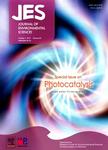Microbial detoxification of metalaxyl in aquatic system
Microbial detoxification of metalaxyl in aquatic system作者机构:Pesticides DepartmentFaculty of Agriculture Kafr El-Sheikh University. Kafr El-Sheikh 33516 Egypt Agriculture MicrobiologyAgriculture Botany Department Faculty of Agriculture Kafr El-Sheikh University Kafr El-Sheikh 33516 Egypt
出 版 物:《Journal of Environmental Sciences》 (环境科学学报(英文版))
年 卷 期:2008年第20卷第3期
页 面:262-267页
核心收录:
学科分类:0830[工学-环境科学与工程(可授工学、理学、农学学位)] 07[理学] 09[农学] 0903[农学-农业资源与环境] 0713[理学-生态学]
主 题:metalaxyl biodegradation microorganisms, toxicity
摘 要:Four microorganisms, Pseudomonas sp. (ER2), Aspergillus niger (ER6), Cladosporium herbarum (ER4) and Penicilluim sp. (ER3), were isolated from cucumber leaves previously treated with metalaxyl using enrichment technique. These isolates were evaluated for detoxification of metalaxyl at the recommended dose level in aquatic system. The effect of pH and temperature on the growth ability of the tested isolates was also investigated by measuring the intracellular protein and mycelia dry weight for bacterial and fungal isolates, respectively. Moreover, the toxicity of metalaxyl after 28 d of treatment with the tested isolates was evaluated to confirm the complete removal of any toxic materials (metalaxyl and its metabolites). The results showed that the optimum degree pH for the growth of metalaxyl degrading isolates (bacterial and fungal isolates) was 7. The temperature 30℃ appeared to be the optimum degree for the growth of either fungal or bacterial isolates. The results showed that Pseudomonas sp. (ER2) was the most effective isolate in metalaxyl degradation followed by Aspergillus niger (ER6), Cladosporium herbarum (ER4) and Penicilluim sp. (ER3), respectively. There is no toxicity of metalaxyl detected in the supematant after 28 d of treatment with Pseudomonas sp. (ER2). The results suggest that bioremediation by Pseudomonas sp. (ER2) isolate was considered to be effective method for detoxification of metalaxyl in aqueous media.



